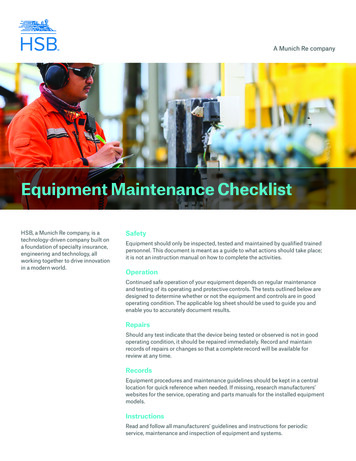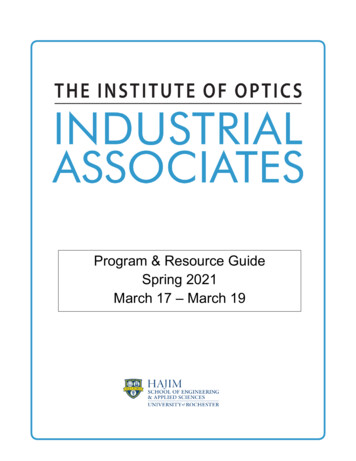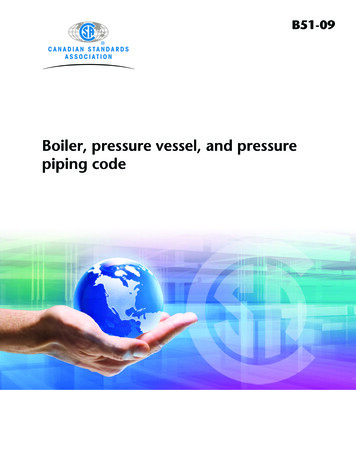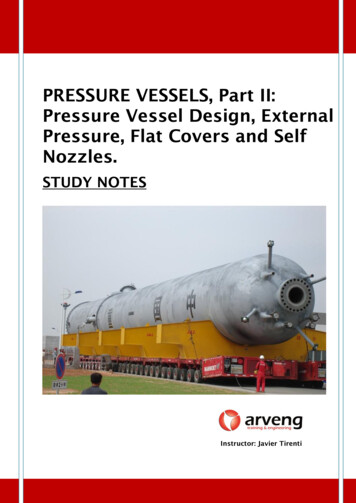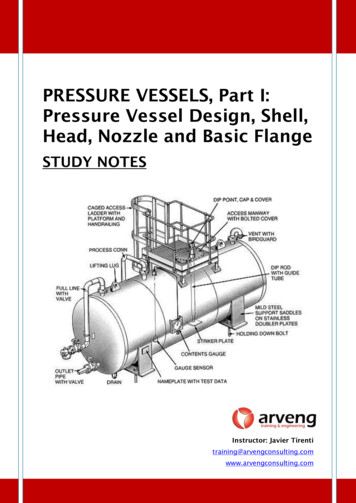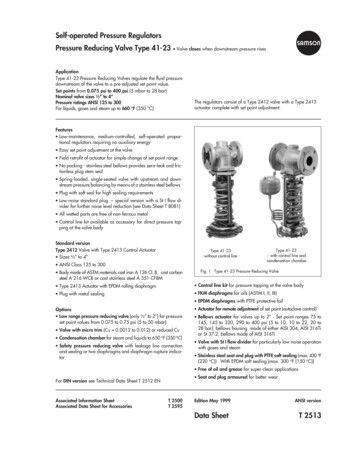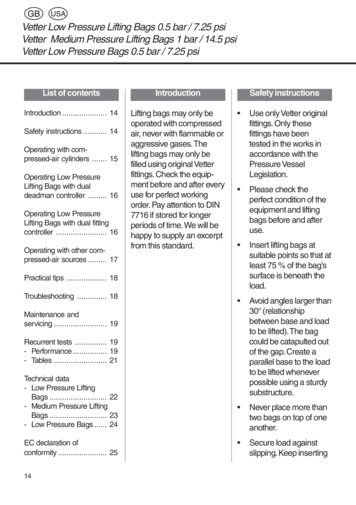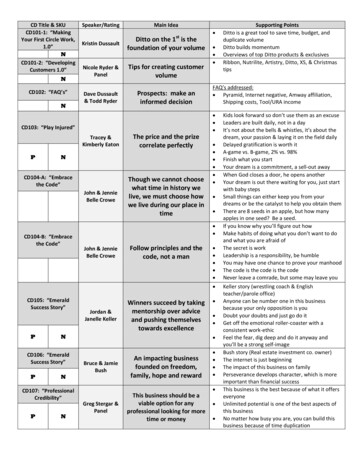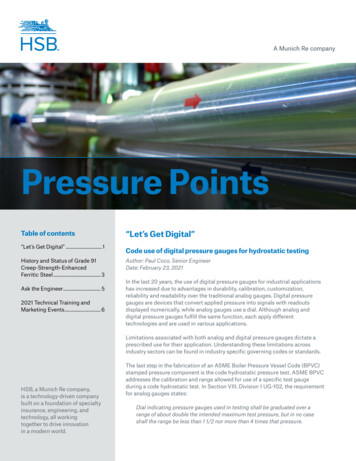
Transcription
Pressure PointsTable of contents“Let’s Get Digital”. 1History and Status of Grade 91Creep-Strength-EnhancedFerritic Steel. 3Ask the Engineer. 52021 Technical Training andMarketing Events. 6“Let’s Get Digital”Code use of digital pressure gauges for hydrostatic testingAuthor: Paul Coco, Senior EngineerDate: February 23, 2021In the last 20 years, the use of digital pressure gauges for industrial applicationshas increased due to advantages in durability, calibration, customization,reliability and readability over the traditional analog gauges. Digital pressuregauges are devices that convert applied pressure into signals with readoutsdisplayed numerically, while analog gauges use a dial. Although analog anddigital pressure gauges fulfill the same function, each apply differenttechnologies and are used in various applications.Limitations associated with both analog and digital pressure gauges dictate aprescribed use for their application. Understanding these limitations acrossindustry sectors can be found in industry specific governing codes or standards.HSB, a Munich Re company,is a technology-driven companybuilt on a foundation of specialtyinsurance, engineering, andtechnology, all workingtogether to drive innovationin a modern world.The last step in the fabrication of an ASME Boiler Pressure Vessel Code (BPVC)stamped pressure component is the code hydrostatic pressure test. ASME BPVCaddresses the calibration and range allowed for use of a specific test gaugeduring a code hydrostatic test. In Section VIII, Division 1 UG-102, the requirementfor analog gauges states:Dial indicating pressure gauges used in testing shall be graduated over arange of about double the intended maximum test pressure, but in no caseshall the range be less than 1 1/2 nor more than 4 times that pressure.
HSBPressure PointsPage 2/6For digital gauges, UG-102 further states:Digital reading pressure gauges having a wider range of pressuremay be used, provided the readings give the same or greaterdegree of accuracy as obtained with dial pressure gauges.The inherent uncertainty in pressure gauges involves: the possibility of error of the transducer monitoring the pressure; the error in the dial representing the measurement; and the human error in reading the gauge.With a digital pressure gauge the third error is eliminated.ASME B40.1 defines the accuracy grades of dial (analog) type gauges while ASME B40.7 defines the accuracy grades ofdigital gauges. For analog and digital pressure gauges the accuracy for grade 3A (code standard for test gauges) testgauges have an error of /-0.25% span over the entire range.Initially this appears to meet the requirements of UG-102, provided in the example that a 100 psig analog or digital gaugewith a 0.25% accuracy is accurate to within 0.25 psig from 0 to 100 psig in both cases. However, digital pressure gauges aretypically used with a wider range than an analog gauge. In this same example the digital pressure gauge range span mightbe from 0-1000 psig with a similar accuracy of 0.25%. This would be accurate to 2.5 psig for the same component beingpressure tested. To address this issue digital pressure gauges can be calibrated to the reading (as grade 3AR) which inmost cases will have smaller errors. In this case, the error will be associated with the actual reading versus the error of theentire span. As an example, a component with a code hydrostatic test pressure of 75 psig would have the followingassociated errors: Grade 3A ASME B40.1 Dial type 0-100 psig error 0.25% - 0.25 psig Grade 3A ASME B40.7 Digital type 0-1000 psig error 0.25% - 2.5 psig Grade 3AR ASME B40.7 Digital type 0-1000 psig error 0.25% @ 75 psig - 0.1875 psigWhen using digital pressure gauges for nuclear applications, Section III in NB/NC/ND-6412(b) takes a different approach.The nuclear code requires that a combined error due to calibration and readability does not exceed 1% of the test pressure.For example, if the test pressure is 4675 psig and the combined error is 51 psig then it would not meet the code since 1% ofthe test pressure would be 46.75 psig.So the question is, how is the combined error determined? The code states that it is due to readability and calibration. Tolook at it we need to understand the digital pressure gauge that is being used.Think of readability as the scale and marks on an analog gauge. The marks might be in the scale of 5 psig increments andtherefore the readability would be 5 psig. The similar thing could be said about a digital gauge when you look at theresolution of the gauge. In most cases for a digital gauge readability and resolution are usually the same. For example, with adigital gauge it may go out 3 decimal places like 0.001. However, if the third decimal place does not give a stable readingand fluctuates wildly or too fast, then the readability is only 2 decimal places. Most gauges are designed to have theirresolution stable which matches the readability. Note this number is what is on display on the digital output and the numberof increments a pressure change is detected. For most gauges they are about 1 or 5 psig depending on the gauge.Next comes the error associated with calibration. In this case, we are looking at the accuracy of the gauge. Digital gaugesare certified to an accuracy of /- some percent of full range. So, a 0-600 psig gauge that is /-1% is /-6 psig. If your testreads 15 psig, that means your reading is between 9 and 21 psig. If you have a 0-50 psig 1% gauge, then a 15 psig reading is14.5-15.5 psig. You can see how this is similar to the range requirements for analog gauges.
HSBPressure PointsPage 3/6Now, let’s look at an example with a test pressure of 1500 psig. Our digital gauge has an unrestricted range of 0-10000 psigwith a readability of 5 psig and an error of /-0.25%. With 1% of test pressure being 15 psig and the combined error being25 psig (Error of the full range) 5 psig (Readability), this digital pressure gauge would not meet the code rangerequirements for the specific test pressure to meet Section III code requirements.Although digital pressure gauges offer many advantages over analog gauges, proper consideration is required to make surecode range requirements are met.About the authorPaul Coco, Senior Engineerpaul coco@hsb.comPaul Coco joined HSB (Hartford Steam Boiler) in January 2014 and is a graduate of the United States NavalAcademy where he earned a Bachelor of Science degree in aeronautical engineering. Paul also holds a Master’sDegree of Engineering Management and a Master of Science Degree in Mechanical Engineering. Paul served inthe U. S. Navy from 2002 through 2010 which included the role of Reactor Mechanical Division Officer andTraining Officer. In 2007 and through 2010, Paul joined the Mechanical Engineering Department at the U. S.Naval Academy where he taught Applied Engineering Thermodynamics for Naval Applications.Paul has also worked as a Reactor Operations Engineer where he conducted detailed technical reviews ofnuclear licenses in accordance with federal codes and standards and performed quality assurance inspectionson domestic and international nuclear vendors for nuclear safety and related components.Within the HSB Codes and Standards group, Paul is responsible for providing code technical support to internaland external clients with a focus on nuclear construction to ASME Section III and the associated nuclearconformity assessment programs.History and Status of Grade 91 Creep-Strength-Enhanced Ferritic SteelAuthor: Jay Cameron, P.E.Date: February 11, 2021Material mechanical properties and allowable stressesThe material specifications’ properties for Grade 91 have been relatively stable since its inclusion in the ASTM (AmericanSociety for Testing and Materials) material specifications. However, due to better processing yields, the specificationminimum tensile strength for forgings was increased in ASTM A182 and A336, and these revised specifications wereadopted in the ASME Code in the 2013 and 2017 Editions, respectively. The Section II, Part D (II-D) allowable stresses wererevised in the 2019 Edition based on these modifications; the allowable stresses in the intermediate-temperature, timeindependent regime were increased up to 6%.However, the biggest impact to the use of this material happened with the elevated-temperature properties. After othercompeting alloys were adopted into the Code, additional data for Grade 91 were obtained and reanalyzed. This resulted inthe Grade 91 allowable stresses at higher temperatures in the time-dependent regime and in thicker sections being reducedabout 7% in 1994. This reduction in properties set in motion global testing of this material — expanding into more and moreheats of materials and evaluations of different product forms (plate, pipe, tube, forgings).Normally, the allowable stresses published in the Code are based on test data extrapolated out to 100,000 hours. Since it isnot practical to conduct all lab tests for 100,000 hours (over 11 years), standard analytical procedures use shorter-term testdata that is linearized and extrapolated to 100,000 hours. This procedure has proven to serve the industry very well for manyother materials.
HSBPressure PointsPage 4/6However, after a significant increase in the amount of data in the data set (including much longer lab tests), the thoroughanalysis of the data revealed an anomaly. With these new data for Grade 91, the longer-time data indicated that there was achange in the slope of the data at lower stresses and longer durations — meaning that the linear extrapolation process usedwas not correct. This means that the stress levels of components operating for a long time could cause creep damage andpossibly cracking or fracture at much shorter lifetimes than the 100,000-hour basis. So, in the 2019 Edition, the allowablestresses were reduced up to 19% at the highest permitted temperatures. [See the following illustration.]lab testextrapolationstressnew datahours to failureMaterial chemistry and allowable stressesParallel to these mechanical property investigations, EPRI (The Electric Power Research Institute) was conducting athorough investigation of the chemistry, microstructure and high-temperature properties of Grade 91 due to some boilercracking issues in the field. Their investigation resulted in recommended chemistry changes that could improve the creepductility and also creep strength. These chemistry changes were first published in Code Case 2864. Code Cases areoptional, so releasing the improved chemistry by Code Case was solely to provide commercial convenience for thepurchaser. However, the Code Case used the same allowable stresses as for the unmodified chemistry. On June 9, 2019,a revision to the Code Case was made to increase the allowable stresses roughly 7% higher than what was publishedin the 2019 II-D.Once the final optimum chemistry was negotiated and agreed to in the ASME Code Committees, the chemistry wasincluded in all the wrought [other than casting] product form material specifications in ASTM. In very quick order, ASMEadopted these revised specifications in the 2019 Edition. The improved chemistry was designated as Type 2 and theprevious chemistry was designated as Type 1. However, the 2019 Section II, Part D was not concurrently revised to explicitlyinclude Type 2, nor its increased allowable stresses. Therefore, since there was no designation of Type in II-D, which meansthat the allowables could be used for either Type — boiler and pressure vessel Manufacturers could use Type 2 withouthaving to use the Code Case, but with the existing allowable stresses.Approved for publication in the 2021 Edition of Section II, Part D are additional stress lines for Type 2 — having allowablestresses roughly 7% higher than those of Type 1. Along with this revision, B31.1 has an action proceeding through theCommittee process to make parallel changes for piping components.About the authorJay Cameron, P.E.jay cameron@hsb.comJay joined HSB (Hartford Steam Boiler) in 1992. He holds a B.S. degree in Mechanical Engineering, EngineeringMechanics from Worcester Polytechnic Institute and an M.S. degree in Metallurgy from Rensselaer PolytechnicInstitute and is a Registered Professional Engineer.Jay provides technical assistance for all non-nuclear ASME Boiler and Pressure Vessel Codes and the NationalBoard Inspection Code (NBIC) and supports clients with design reviews. His technical expertise is in the areasof pressure vessel design and repair, stress analysis and materials.Jay currently serves as Chair of BPV II (Materials) and Vice Chair of the Subgroup on Materials (BPV VIII) and isa member of the Special Committee on Interpretations (BPV VIII). He has presented courses on pressure vesseldesign to audiences around the world.
HSBPressure PointsPage 5/6Ask the EngineerQuestion: When conducting the final pressure test in accordance with UG-99 or UG-100, is it required that the gaskets andbolting installed on all flanges, including temporary closures used just for the pressure test, be identical to the hardware thatwill be actually installed on the vessel in service?Response: This issue was addressed by the Committee for the first time in Interpretation VIII-1-86-189, published inDecember 1987. Below is an excerpt from this Interpretation, specifically Questions and Replies (5) and (6).Interpretation:Subject:Date Issued:File:VIII-1-86-189Section VIII, Division 1, UG-99December 14, 1987BC87-426Question: For purposes of hydrostatic testing, is the gasket considered part of the pressure vessel?Response: Yes.Question: With the concurrence of the owner/user, is it permissible to use gaskets in the required hydrostatic test that havephysical characteristics similar to the gaskets used in the design calculations?Response: Yes.As you can
23.02.2021 · ASME B40.1 defines the accuracy grades of dial (analog) type gauges while ASME B40.7 defines the accuracy grades of digital gauges. For analog and digital pressure gauges the accuracy for grade 3A (code standard for test gauges) test

